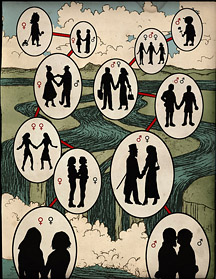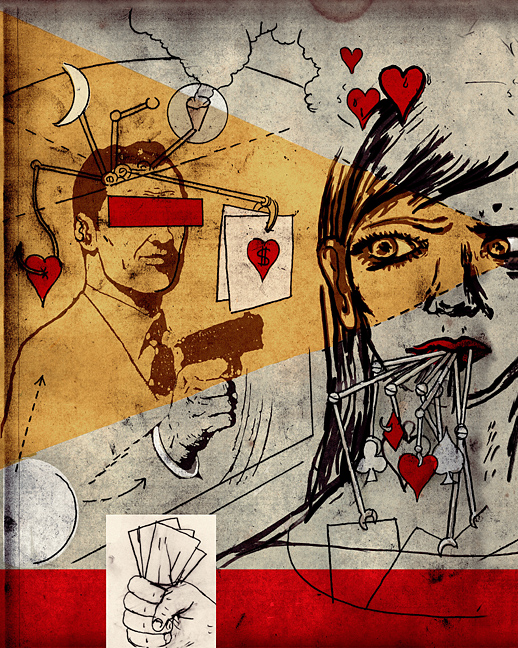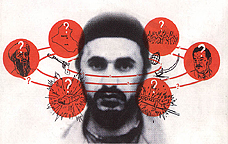Time Magazine. An army of Chinese hackers target
American military and infrastructure.
|
|
|
Discover Magazine : Who You Callin' "Bird
Brain"?
The amazing smarts of crows, jays, and other corvids are forcing scientists to rethink when and why intelligence
evolved.
|
|
|
LETTERS / NYT Sunday Review: Sunday Dialogue: Bird
Flu Experiments
|
|
|
|
|
|
|
|
|
|
|
|
Story of a Jazz Age Murder. New York Times Book Review
6/17/11.
|
|
|
|
In using the crime as the basis of his new novel, “A
Wild Surge of Guilty Passion,” Ron Hansen joins a distinguished group of writers for whom it has served as an imaginative
platform: Sophie Treadwell, James M. Cain, Raymond Chandler and William Styron. More recently, Landis MacKellar published
“The ‘Double Indemnity’ Murder: Ruth Snyder, Judd Gray and New York’s Crime of the Century”
— a comprehensive yet streamlined nonfiction account, well researched and humane, that’s as gripping as a thriller...
|
|
|
BOOKS ON SCIENCE
From Hitler to Mother Teresa:
6 Degrees of Empathy
|
|
|
|
Published: June 13, 2011 NY TIMES.
“The Science
of Evil,” by Simon Baron-Cohen, seems likely to antagonize the victims of evil, the parents of children with autism
spectrum disorder, at least a few of the dozens of researchers whose work he cites — not to mention critics of his views
on evolutionary psychology or of his claims about the neurobiology of the sexes. “The Science of Evil” proposes
a simple but persuasive hypothesis for a new way to think about evil.
|
|
NY Times Week In Review, May 2011; a startling clinical
study about liposuction, the most popular plastic surgery, with more than 450,000 operations
a year.
|
|
|
NY Times Week In Review, May 2011; a startling clinical
study about liposuction, the most popular plastic surgery, with more than 450,000 operations
a year.
|
|
|
Discover Magazine, 2011; 20 Things series.
|
|
|
|
Mother Jones Magazine April, 2011; The Science of Why We Don't Believe Science.
|
|
|
|
|
How our brains fool us on climate, creationism, and the vaccine-autism link.
|
|
|
Ny Times OP-ED March, 2011.
Giving Life After Death Row.
|
|
|
|
ASSET INTL. DEC. Feature: Rebalancing.
|
|
|
ASSET INTL. DEC. Feature: Rebalancing—Tactical moves you have
for shifting asset allocation during periods of crisis
|
|
|
|
|
Wall Street Journal, August 2010:
ETFs Shunned by Many Plans. Investment advisers are big fans of exchange-traded funds, but that often doesn't extend to
putting them on the menus of corporate retirement programs.
|
|
|
|
A precursor to the Kindle/iPad--in the 1930s, New York Times Book Review Essay:
The Godfather of the E-Reader
|
|
|
|
|
Before Bezos, before Jobs, there was Bob Brown, who wrote, in a 1930 manifesto titled "The Readies": “It is time to
pull out the stopper” and begin “a bloody revolution of the word.”
"To continue reading at today's speed," he wrote, "I must have a machine. A simple reading machine which I can carry or move
around, attach to any old electric light plug and read hundred-thousand-word novels in 10 minutes if I want to ..."
The basic idea is that you absorb a never-ending line of text streaming by at lightning speed, sans articles and other connective
tissue. Gertrude Stein and Ezra Pound wrote texts designed for Brown's machine...
|
|
|
Taking the Mystery Out of Web Anonymity. New York Times Week in Review 7/2/10.
|
|
|
|
|
|
|
THE Obama Administration is trying to fix the Internet's dog problem. The problem, as depicted in Peter Steiner's legendary
1993 New Yorker cartoon, is that on the Internet nobody knows you're a dog. And thus the enduring conundrum over who can be
trusted in cyberspace.
The Internet affords anonymity to its users, a boon to privacy and freedom of speech. But that very anonymity is also
behind the explosion of cybercrime that has swept across the Web.
Can privacy be preserved while bringing a semblance of safety and security to a world that seems increasingly lawless?
Click to see the actual paper PAPER.
|
|
|
AI5000; Environmental Investing: Debunking the Myths - June / 2010 issue.
|
|
|
|
NY Times op ed.
|
|
|
|
Waxed Oop. Fast n Bulbous.
|
|
|
|
OK, here are the Pages and Spreads from YOUR BODY INC. / NOV. ISSUE, INC. MAGAZINE, 2009.
|
|
|
|
Stanford Medical Magazine, July 2009.
The promise and future of basic bio-chemical research.
|
|
|
|
|
| |
| |
|
Sept. 2008, NY Times Week in review: In a matter of about 12 minutes more than $1 billion in United Airlines market value
stock-evaporated...automatically.
|
|
read.
|
|
One of many drawings for Amy Stewart's WICKED PLANTS.
|
|
|
|
|
"Delightfully macabre...With drawings that illustrate the fate of the incautious, Stewart's original take on the plant kingdom
is one worth seeking, if only to avoid its contents." --SEED Magazine
|
|
|
NY Times, August 2009.
Finally, the Spleen Gets Some Respect.
|
|
|
|
| |
Scientists have discovered that the spleen, long consigned to the B-list of abdominal organs and
known as much for its metaphoric as its physiological value, plays a more important role in the body’s defense system
than anyone suspected.
Read it here
|
|
|
The Muddled Tracks of All Those Tears, NY Times Science Section, February
2, 2009.
They’re considered a release, a psychological tonic, and to many a glimpse of something deeper:
the heart’s own sign language, emotional perspiration from the well of common humanity.
|
|
|
ATMOSPHERIC DISTURBANCES
NYTimes Book review, cover. July 2008.
|
|
| |
|
| |
“Atmospheric Disturbances,” a brainy, whimsical, emotionally
contained first novel by Rivka Galchen, a young M.D. turned M.F.A.
Galchen’s narrator, a fussy 51-year-old psychiatrist named Leo Liebenstein, believes that his beautiful, much-younger
Argentine wife, Rema, has been replaced by a “doppelgänger,” a “simulacrum,” an “impostress,”
an “ersatz” spouse. “Last December,” Leo explains, “a woman entered my apartment who looked
exactly like my wife.”
|
|
Nov. 2008, NY Times Health Section:
Many people refuse to get their teeth x-rays due to IRRATIONAL RADIATION FEARS.
|
|
|
|
July/2008, NY Times Op-Ed: Unidentified Flying Threats
|
|
|
| |
| |
Hotwire Magazine: A stroke of bad luck. 2008.
|
|
|
Artwork for an entire special issue of the NY Times Science Section.
Sleep. Oct, 2007.
|
|
Click to see the spreads and a clip.
|
The Believer, 11.07. is HOLY so that the BELIEVER may gaze @& upon rub-on
tatoos through HOLES.
|
|
|
King Algorithm:
An Oracle for Our Time, Part Man, Part Machine. NYTimes Week in Review, sept 2007.
|
The mating of the human and machine brain. Click
picture to see unfolded big.
|
Mother Jones, September/October 2007. Gay by Choice? The Science of
Sexual Identity. News: If science proves sexual orientation is more fluid than we've been led to believe, can homosexuality
still be a protected right?
|
|

|
NYTimes Science Times 7/3/07:Winding Through ‘Big Dreams’
Are the Threads of Our Lives
|
“Back to life” or “visitation” dreams, as they
are known among dream specialists and psychologists, are vivid and memorable dreams of the dead. They are a particularly potent
form of what Carl Jung called “big dreams,” the emotionally vibrant ones we remember for the rest of our lives.
|
Plansponsor Magazine, summer 2007. Building your own, an article about
customizing your financial investments.
|
|
|
Cover LA Times Book Review section: Monkey Girl: Evolution, Education,
Religion, and the Battle for America's Soul by Edward Humes (Author)
|
What's in a name? For supporters of the theory of "intelligent
design" (ID),
a great deal. They argue that the complexity of our universe is best understood as the result of an intelligent
cause rather than the undirected process of natural selection described by Charles Darwin, and they want to see this taught
in public school science classes. ID is not religious, they argue; it is simply scientific. But critics of ID argue that it
is merely a more sophisticated way of promoting "creation science," which rejects evolutionary theory in favor of a literal
reading of the book of Genesis and therefore promotes the teaching of religion in public schools.
Humes takes the title of his book, Monkey Girl, from the taunt leveled at a child whose mother objected to the new policy.
Some parents, including teachers in the school district, viewed intelligent design as a stealth form of
creation science.
Although many of these parents were Christians (two even taught Sunday school), they felt that teaching ID in a public school
classroom improperly injected religion into education. |
MOTHER JONES; Pop neuroscience promises to reveal the secrets of life.
Too bad the brain is a gray area.
|
|
Three books reviewed in Mother Jones...
The Naked Brain: How the Emerging Neurosociety Is Changing How We Live,
Work, and Love
By Richard Restak
Harmony Books.
The Female Brain
By Louann Brizendine
Morgan Road Books. 2
A Mind of Its Own: How Your Brain Distorts and Deceives
By Cordelia Fine
Norton.
A recent article in Newsweek titled "This Is Your Brain on Alien Killer Pimps of Nazi Doom" reported on a study in which researchers
scanned the brains of teenagers playing a violent video game and another group of teens playing a driving simulator. Kids
who played the first-person shooter for 30 minutes "showed higher activity in the emotional centers of the brain, and less
in the areas of concentration and inhibition" for an hour afterward. The study provided no direct link between badass games
and badass behavior, but that didn't stop the mother of one 14-year-old research subject from taking away his gaming console
and encouraging him to play Monopoly instead. After all, there's nothing wrong with a game that rewards you for ruthlessly
driving your opponents into bankruptcy.
|
NYT Science Times section cover; Free Will: Now You Have It, Now You
Don't.
|
|
|
Blab! 17 wraparound cover. Selected for inclusion into the SOCIETY OF
PUBLICATION DESIGNERS (42nd) and AMERICAN ILLUSTRATION (26th) ANNUALS.
|
|
|
Standford Medicine magazine; article about organ transplant medical
zones and organ distribution.
|
|
|
LA MAGAZINE > Blade Runner; 25th anniversary. Spread. |
|
|
|
LA MAGAZINE > Tomorrow is the drug. Hollywood's latest encounter with Phillip K Dick.
|
|
|
|
Lymphocytes, Camera, Action ! Digital video vignettes of the immune system in action are opening scientist's eyes.
|
|
|
|
In a laboratory at Standford University school of Medicine graduate students and post docs spend alot of time watching movies.
Their mentor, HHMI investigator Mark M. Davis, doesn't mind a bit. In fact, he encourages them, and proudly shows off the
product of a protégé's doctoral thesis, which he unofficially titles, "Immune System: The Movie"; The student composed
digital video recordings of immune cells going about their machine-like business--not unlike Hollywood's Terminator----of
seeking out, recognizing, and destroying (or stimulating) other cells.
|
|
|
Voyage Along the Horizon by Javier Marías. Published by Believer Books.
|
|
|
|
Voyage Along the Horizon is an affectionate (if slightly sardonic) homage to the great adventure tales of the late nineteenth
century. Like those stories, this one revolves around an intrepid expedition: The eccentric, wealthy Captain Kerrigan, an
attractive man with a shadowy past, organizes a trip to Antarctica for a select group of writers, artists, and scientists.
Amid sudden kidnappings, torrid manuscripts, Edwardian spinsters, and lethal duels, this seafaring tale is also a narrative
of psychology, obsession, the writer's craft, and human nature, all of which Marías has wrapped up in an evocative, nostalgic
novel that is both witty and dark. Fascinated by the question of uncertainty, Marías eschews the solution and prefers to revel
in the narrative process itself, and asks the reader to consider the possibility that the truth as we know it isn't nearly
as interesting as its own shadow.
|
|
|
Dose Magazine, Canada. Can the Mind heal the Body ? Mesmerism in ACTION.
|
|
|
Weston Magazine. THE BANK ROBBERY a story by Steven Schutzman. Sept
2005. NOTE: Please don't hot
link to my pictures. Please don't steal and repost them, either. This is what I do for a living. Thanks.
|
|
|

|
| |
[excerpt:] The bank robber told his story in little notes to the bank teller. He held the pistol in one hand and gave her
the notes with the other. The first note said: This is a bank holdup because money is just like time and I need more to keep
on going, so keep your hands where I can see them and don't go pressing any alarm buttons or I'll blow your head off.
The teller, a young woman of about twenty-five, felt the lights which lined her streets go on for the first time in years.
She kept her hands where he could see them and didn't press any alarm buttons. Ah danger, she said to herself, you are just
like love.
|
|
|
|
Radical Fashion. A new series of silhouette drawings for PAPER Magazine. Sept 2005. Click the picture to see them all.
|
|

|
|
The Economic Unit Called Supermom
So how to value mom's benevolence and hard work? Published: May 8, 2005. NYTimes Week in review.
|
|
|
|
A handwriting transmission machine in action. Published in the March '05 issue of PAPER Magazine.
|
|
|
|
A spread for Boston Magazine about Mr. Lawrence Summers, the smooth-talking president of Harvard University.
|
|
|
|
A spread from Runner's Magazine about a marathon in Cuba.
|
|
Photo by David Nicolas.
|
|
CD Cover for Val-inc's record; 'ON'
|
|
|
|
An essay on ipod psychology & personality insight. New York Times Week in Review section, Nov. 2004.
|
|
|
|
Who is Abu Musab al-Zaqawi ? New York Times Week in Review section, Oct 2004.
|
|

|
|
The cd cover of Ryuichi Sakamoto's Moto.tronic (click to enlarge)
|
|
|
|
Circus mutations, a CD cover for an Imago Record Company music compilation
|
|

|
|
Leonardo DiCaprio. Commissioned for the film Gangs of New York. Published by Entertainment Weekly.
|
|
|
|
Hey, Mister ! Could you please entertain us to death ? A project for Blab! #13.
|
|
|
|
The Seamy River. A project for Blab! Recieved a silver award from the Society of Publication Designers, (SPD) 2002.
|
|

|
|
Cosmic love pulse matrix. A piece concieved for the "dots" box for the picturemechanics group.
|
|
|
|
A spread, one of several pieces from the New York Times Sunday Magazine for an article about cyber-privacy issues.
|
|
|
|
For POZ Magazine. This piece is about people with AIDS who are rejected by their religious affiliation or place of worship.
|
|
|
|
From discover magazine, for an article about tool using monkeys.
|
|
|
| |

